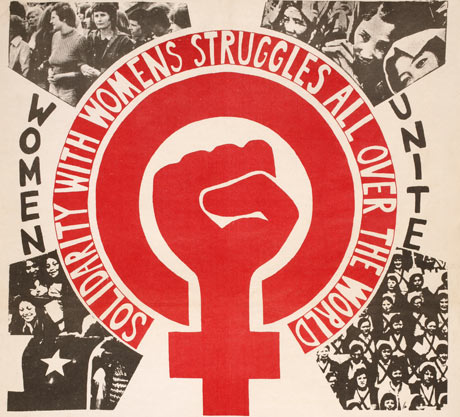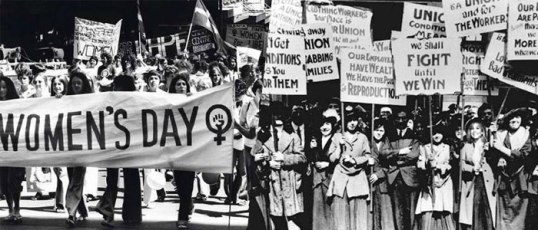The Story of International Women’s Day
The Story of International Women’s Day
H. Bradford
3/4/17
I first became aware of International Women’s Day when I was in my early 20s. I learned about it through my Russian language class in college. The professor gave all of the women in the class a flower and explained that the holiday was a little bit like Valentine’s Day or Mother’s Day in Russia. This quaint and apolitical version of International Women’s Day remained my template for understanding the holiday until after I became a socialist. This understanding mirrored my understanding of May Day as a spring holiday with cute baskets. Yet, both holidays are more than just flowers and baskets. They are both celebrations that honor a long history of struggle against capitalism.

You mean International Women’s Day is not just a cute Russian holiday?
The Socialist Roots of International Women’s Day:
While I learned about International Women’s Day in the context of Russian culture, the holiday, like May Day, actually originates in the United States. The first “National Woman’s Day” was organized by the Socialist Party and held on February 23, 1909. The New York event was attended by over 2000 people and featured speaks such as Charlotte Perkins Gilman and Leonora O’Reilly. The first “National Woman’s Day” focused on suffrage and women’s equality. It was also called in support of ongoing labor organizing of garment workers, such as march of 15,000 workers which had occurred the year before. At the time, socialists wrestled with the issue of balancing the demand for suffrage with their traditional focus on the economic rights of women, but ultimately, committed themselves to both through the advocacy of women within the socialist party. Like May Day, the holiday was later popularized in Europe. In 1910, women from 100 countries, consisting of socialists, labor organizers, working women’s clubs, and three female Finnish members of Parliament, gathered in Copenhagen for the Second International Congress of Women. It is at this meeting that German socialist, Luise Zietz and Clara Zetkin, motioned to create an International Women’s Day the following year. The first International Women’s Day event was held March 18, 1911 and featured over a million demonstrators across Europe who used the event commemorate the 40th anniversary of the Paris Commune and assert the economic and political rights of women. That same year, on March 25, 1911, 146 mostly immigrant women lost their lives in the Triangle Shirtwaist Factory Fire in New York. Because of unsafe working conditions, including locked doors to prevent theft and a lack of fire alarms on some of the floors, a fire originating in a pile of scrap material killed a quarter of the workforce in less than twenty minutes. The fire was a catalyst for new safety regulations and a rallying cry for unionizing garment workers. It was also memorialized in future International Women’s Day events.
Early International Women’s Day observances were focused on labor, suffrage, and other facets of political and economic equality. While the relationship between socialists and suffragists was uneasy, the socialists became increasingly committed to suffrage and collaborating with suffragists during this time period. American socialists actually marched together with suffragists in Boston a few days before women’s day in 1911. While suffrage seems obvious today, at the time, socialists worried that suffrage would mean women could be drafted, thereby becoming instruments of capitalist wars. There were also concerns that women were politically conservative and that suffragists tended to consist of wealthier and middle class women whose interests were not the same as working class women. Despite misgivings socialists had regarding suffrage, the early celebrations of women’s day were expressions of their commitment to the economic and political equality of women. According to the Russian socialist, Alexandra Kollontai (1920), North American socialists played a prominent role in arguing to other socialists that suffrage was a worthy demand.

International Women’s Day and the Russian Revolution:
Peace became another central demand of International Women’s Day organizers during World War One. Unfortunately, socialists who had been elected into office, were blinded by nationalism and voted to enter World War One, thereby discrediting Socialist Parties. However, in 1915 Clara Zetkin called a conference of women in Bern, Switzerland and encouraged them to demonstrate against war, even if this meant treason. Women from countries involved in World War One were denied passports to attend this meeting and unfortunately, the only country that managed to host a demonstration in 1915 was Norway, though some women from war beleaguered European countries managed to attend. It is during this time that International Women’s Day was first celebrated in Russia, which went on to play an important role in the holiday’s history. The first Russian “Working Women’s Day” was organized in 1913 as a meeting, as demonstrations were illegal in tsarist Russia. The following year, organizers for a “Working Women’s Day” were put into prison and the demonstration was stymied by police intervention. State repression prevented Russian further observances of International Women’s Day until 1917 By then, the Russian population was weary from war, poverty, hunger, and tsarist autocracy. The threat of imprisonment could not contain the anger of the masses. On March 8th, 1917, or February 23rd by our calendar, women in Petrograd took to the streets to demand bread and an end to the war, which had taken the lives of two million Russians. Garment workers played a central role in the strike, but other workers joined them, swelling to a mass of 75,000 workers on the first day and 200,000 on the second. By the third day, 400,000 workers participated in the strike in Petrograd. Four days later, military garrisons revolted and police went into hiding. The International Women’s Day strike in Petrograd spread across the country, becoming what is now known as the February Revolution. The revolution resulted in the abdication of the tsar a week later, ending over 400 years of tsarist rule and set the stage for the October revolution later that year.
The Russian revolution ushered in a variety of advances for women. The October revolution granted full suffrage to women and enacted equal pay. Russia became the first country to legalize abortion, which it provided free and on demand until Stalin came to power. Divorce became easily obtainable and marriage was treated as a civil matter rather than religious affair. Daycares and communal kitchens and laundries were established to alleviate the burden of unpaid labor. Paid maternity leave was also extended to women, something that the United States lacks 100 years later. All of this was granted to women during a time of civil war and economic collapse on the already shoddy foundation of centuries of tsarist autocracy and an undeveloped economy. Many of these remarkable accomplishments were later rolled back by Stalin, who rebranded International Women’s Day as a benign Soviet Valentine’s Day. The revolutionary character of the holiday was largely forgotten and the holiday itself became associated with communism, as countries ruled by Communist Parties tended to be the ones which made it an official holiday. Like May Day, Cold War politics, which sought to tame, ignore, or persecute the far left, meant that International Women’s Day went mostly unnoticed in the U.S.

The Struggle Continues:
International Women’s Day was a largely Communist holiday until the late 1960s. The emergence of the feminist movement in renewed interest in the holiday, though, since socialists participated in the feminist movement, they may have played a role in promoting the holiday. In any event, the holiday became less associated with communism after International Women’s Day was promoted by feminists and adopted by the United Nations in 1975. As of 2014, International Women’s Day was observed in over 100 countries. The United Nation’s version of International Women’s Day doesn’t quite capture the militant spirit of the original celebrations. Each year has featured a theme, such as human rights, decision making, progress, and empowerment. However, these themes often sound more like Girl Scout Badges that women should earn rather than rallying calls for the next revolution. Thus, for most of my life as a feminist, I have been disappointed by the lack of interest or action around the holiday. The Feminist Justice League, formerly known as the Twin Ports Women’s Rights Coalition, has organized International Women’s Day events in the past, but these were never well attended and there was never much community interest in them.
All of this has changed this year after four million women marched on January 21st. In the wake of this event, the Women’s March has called for 10 actions in 100 days. Prior to calling for a “Day without a Woman” Strike on March 8th, feminists around the world were calling for a strike. Women in Poland, Ireland, and Argentina have been particularly active in this call. In Ireland, women plan to strike on March 8th in protest of restrictive abortion laws there. In October, women in Poland striked against the introduction of legislation which sought to criminalize in all cases but imminent danger to the mother’s life. In Argentina, and across Latin America, women striked against femicide in October, catalyzed by the gruesome rape and murder of Lucia Perez. The strikers tied the violence against women to the economic conditions that women face, such as unpaid labor, unequal wages, and neoliberal reforms that have cut public spending, all of which render women unequal and vulnerable. In solidarity with these struggles, and to spotlight the economic component of women’s oppression, the Women’s March called for a strike on March 8th. This strike was called in mid-February. As a result of the resurgence of feminism, events will be held all over the United States and abroad. Locally, the Feminist Justice League is hosting a 78 minute symbolic strike, followed by a march and a panel which focuses on women as workers. This event will be held at 5 pm on March 8th at the MN Power Plaza. However, it is one of a dozen local events. Other events include an the Feminist Action Collective’s International Women’s Day celebration on March 10th at Beaner’s, Domestic Violence Action Day on March 7th at noon at the Duluth City Hall, PAVSA’s pack the Plaza at 11:30 am on the 8th, and a solidarity with Honduras event at 2:30 at the Building for Women on March 5th. This is just a sample of the wave of feminist actions for International Women’s Day.

Conclusion:
I am excited by the revival of interest in International Women’s Day and feminism in general. Sometimes there is so much activity that I worry that I will be washed away in this new wave of feminist activity. At the same time, I am incredibly proud to be a socialist. Some people enjoy pointing out their genealogy, finding joy that at some point in history they descended from a king or Viking. I take pride in my socialist genealogy. I take pride in my membership to a party which descends from the Russian revolution and from the socialists before this. I feel that the history of International Women’s Day is my history. It is my history as a socialist, as a worker, and as a woman. Of course, International Women’s Day should be for everyone. The story of garment workers dying in a fire continues to be the story of all workers who face dangerous conditions. The story of immigrant women who were afraid to organize because of their marginal position in society, continues to be story of immigrants. The story of women standing up against the senseless loss of war should still be our story. The story of women standing up to soldiers and the police, protesting in the face of state repression, should still be our story. This gives new meaning to, “…and still she persisted.” The story of women trying to build an international feminist movement should be our story. The story of women connecting femicide to neoliberal policies and economic inequality should be our story. The story of women making revolution should be our story.

Sources:
http://america.aljazeera.com/articles/2015/3/7/socialist-history-of-international-womens-day.html
http://kclabor.org/wordpress/?m=201703
http://america.aljazeera.com/articles/2015/3/7/socialist-history-of-international-womens-day.html
https://iwd.uchicago.edu/page/international-womens-day-history
http://www.smithsonianmag.com/history/russias-february-revolution-was-led-women-march-180962218/
https://www.marxists.org/archive/kollonta/1920/womens-day.htm
http://isreview.org/issue/75/februarys-forgotten-vanguard